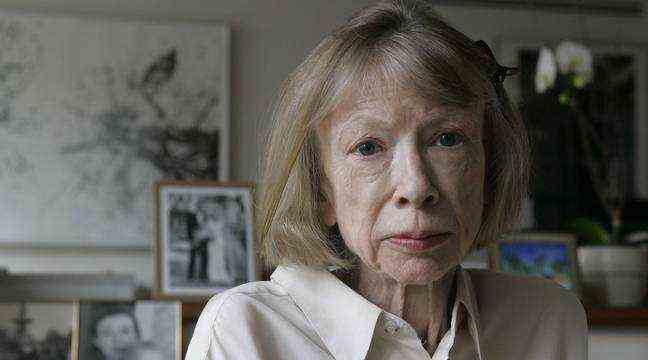A figure in the great American tradition of literary journalism has died out. American author and journalist Joan Didion, a literary icon in the United States known for her chronicle of California in the 1960s, died Thursday at the age of 87, announced the New York Times.
Both novelist, journalist, essayist and screenwriter for Hollywood, the author died at her home in Manhattan from Parkinson’s disease, her editor Knopf-Penguin Random House said, paying tribute to one of the “sharpest” writers and “one of America’s most discerning observers”.
“She was fierce and feared nothing in her reports”
Throughout his career, Slouching Towards Bethlehem (1968) to The year of magical thinking (2007), she was celebrated both for her acuteness in describing contemporary American society, but also for her autobiographical talents. “She was fierce and feared nothing in her reporting. His timeless and powerful writing and prose have influenced millions of people, ”praised Knopf editor Shelley Wanger.
Born in Sacramento on December 5, 1934, Joan Didion divided her life between California and New York. After studying literature at the University of Berkeley, she left in 1956 for the cultural capital of the east coast of the United States, where she began as a proofreader at Vogue. It was also in New York that she met her husband John Gregory Dunne, who wrote for the magazine at the time. Life.
In 1963, Joan Didion published her first novel, Run River (“A Season of Nights”), but this book on the disintegration of a Californian family hardly sells and will confirm the end of her passion for New York, as she later explained in an article. Goodbye to all that (“Goodbye to all that”), text that paints a capital of skyscrapers all in poetry and disillusion. The couple leave New York for Los Angeles. They get married and make a place for themselves in Hollywood, where they write and collaborate on numerous screenplays, including a remake. a star is born. In 1966, they also adopted a little girl, Quintana, their only child.
Discovering the hippie counter-culture
Joan Didion leaves in the summer of 1967 for San Francisco, documenting the hippie counterculture for the Saturday Evening Post. From this dive into a world of young people adrift in the Haight-Ashbury district, then in full discovery of drugs and acid trips, emerges a text that has remained famous, Slouching Towards Bethlehem, a first-person report that made her a figure in the new journalism.
His documentation of the cultural and social turmoil of California in the 1960s and 1970s continues, through his chronicles in Life and Esquire, and is the subject of another collection, The White Album, published in 1979.
Several awards
Returning to New York with her husband at the end of the 1980s, she learned about political journalism and gathered her experiences in a 2001 collection, Political Fictions. Fifteen years later, some will see his description of a “professional political class” disconnected from the daily life of voters as a premonitory warning from the Trump era.
The death of her husband, of a devastating heart attack at the end of 2003, then that of their daughter Quintana in 2005 paralyzes her for a time. But she draws the energy from her grief to write two autobiographical accounts, The year of magical thinking (2007) – awarded the prestigious National Book Award, the Medici Essay Prize in France and transposed to the theater with Vanessa Redgrave starring – and The Blue of the Night (2011). With many psychoanalytic references, she dissects the springs of mourning and loss of control, giving her lucidity a new dimension and a new audience.
The face hollowed out of wrinkles, the silhouette more frail than ever, she had accepted an award from the hands of the former president Barack Obama in 2013. In 2015, she posed for an advertising campaign of the couturier Celine. The photo immortalizes him as a cult figure, his face behind big black sunglasses, like decades earlier, behind the wheel of a white Corvette Stingray. She had also told herself without complacency, in the privacy of her apartment on the Upper East Side, in Manhattan, for a documentary directed by her nephew Griffin Dunne, The center will not hold (2017), under the inspired title of one of his 1967 articles.

